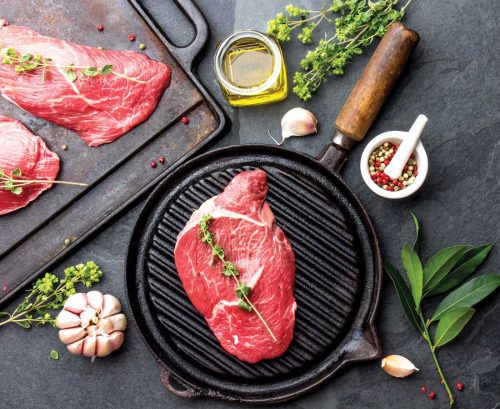How much meat is healthy to eat?
Is meat still okay to eat, are plant foods the way of the future, or is there a sweet spot in between that’s healthy for us and the environment? Healthy Food Guide looks at the science around meat in our diet and how to get the balance right.
It’s hard to ignore the conflicting opinions on meat consumption that have been hitting the headlines recently. Late last year, a research review judged evidence behind recommendations to limit meat intake to be weak, saying there were very few health benefits from cutting meat intake. This advice, however, contradicts accepted dietary guidelines. On the other side of the fence, vocal vegans and animal rights activists protest that we should be all ditching meat in favour of plant foods. Let’s check out the latest science.
The good news about meat …
Meat has been a regular dinner plate fixture for as long as most of us can remember. There’s a good reason: red meat is a valuable source of iron, protein and other important nutrients like zinc, vitamin B12 and omega-3 fats.
Energy-boosting iron is especially important for women, who have greater requirements than men in many age groups. Red meat is an easily absorbed source of iron, which helps prevent anaemia. One in four Australian women are not meeting their iron requirements, and 15 per cent have anaemia. Symptoms of iron deficiency anaemia can include constantly feeling tired and a lack of concentration.
Red meat is also a good source of muscle-building protein. The latest CSIRO research suggests that an increase in protein intake is important for weight management, because protein helps manage our hunger and reduces cravings later in the day. Lean red meat, chicken, eggs, legumes and dairy foods like milk and yoghurt are all quality protein sources.
The no-so-good news about meat…
The link between red meat and a variety of health conditions has long been known. The evidence against eating too much red meat is strongest for bowel cancer, the world’s second-biggest cancer killer. One in six new bowel cancer cases is linked with eating too much red and processed meat (such as ham, bacon, salami and sausages).
In 2015, the World Health Organization declared processed meats as a Class 1 carcinogen. In other words, it said there’s strong evidence that processed meats cause cancer. The Cancer Council advises that meat eaters should limit red meat to three or four times a week (no more than 700g raw weight per week) and choose fish, chicken and legumes on other days. Processed meats should be cut out or minimised.
Then, of course, there’s our heart health. Processed meats and fatty cuts of red meat contribute saturated fat to our diet. Eating too much saturated fat is linked to high cholesterol levels, which ramps up our risk of heart disease and stroke. The Australian Heart Foundation has released new guidelines around red meat intake and heart health, based on the latest evidence.
“We have introduced a limit of less than 350g per week for unprocessed beef, lamb, pork and veal,” the Heart Foundation chief medical advisor and cardiologist Garry Jennings says. “That’s around one–to–three lean red-meat meals a week, like a Sunday roast and a beef stir-fry.”
Trimming fat from meat and choosing lean cuts is one way to lower your saturated fat intake. Reducing your portion size of red meat, and adding more vegetables to your plate, is another way to prevent disease.
How much meat is too much?
So, if eating too much meat can set us up for health problems, should we all go vegetarian? Well, not necessarily. It comes back to one key word: moderation. There’s no problem with a modest intake of lean red meat. But what does ‘modest’ mean, you might be thinking?
Dietary guidelines recommend a maximum of 455g cooked (600–700g raw weight) lean red meat per week, in order to meet iron and zinc recommendations. That’s about one small portion (65g cooked/100g raw) if you’re eating it every night of the week, or one larger portion (130g cooked/200g raw) every second day.
The reality is, most of us eat already pretty close to these recommendations, eating an average of 57g cooked lean red meat (beef, lamb or pork) per day. There is, however, one group who regularly exceed the upper limit, especially when you add in processed meats (bacon, ham, salami). Yep, its men.
Meat consumption is highest among men aged 19–50 years and all teenagers between 14–18 years. Its perhaps no surprise that women and girls are already at the lower end of the recommended meat consumption range — which is not ideal, given their increased iron requirements.
How to get the balance right when it comes to eating meat
Meat doesn’t have to come off the menu for good. Instead, focus on variety, which includes different meat cuts, as well as veges and carb foods. Here are easy ways to get more diversity and balance at every meal
Plan meals ahead
Meal planning is an easy way to get more variety and more nutrients into your diet — plus it saves you precious time! Try to base your meals around different proteins. For example, include lean red meat two-to-three times a week, fish twice a week, make one or two legume-based dishes, and create egg or chicken dishes on other days.
Make veges the hero
Whether as a perfectly cooked roast, or tender, juicy steaks, meat has long been the main event on the dinner table — closely followed by carbs. It’s now time to make veges shine. Rather than thinking of vegetables and salad as a side dish, get creative with new ways to make them the star.
For example, roast a large tray of colourful root vegetables with garlic, rosemary and a drizzle of sticky balsamic glaze, or throw together a filling green salad with toasted nuts, crumbled feta and roasted pumpkin. When vegetables taste this delicious, they quickly become the main event — with meat just the sideshow!
Introduce ‘Meat-free Monday’
If your plan to cut back on meat runs into a bit of resistance — especially from the men in the house — start small by introducing one meat-free dinner per week. It’s a creative way to explore new foods you haven’t tried before, such as tofu, beans and lentils — and you’ll also be doing your health, not to mention the planet, a favour.
Search our recipes for hundreds of delicious vegetarian and vegan dishes.
Be portion wise
A balanced meal often comes down to getting your portions right. As a simple rule, fill half your plate with veges, one-quarter with protein (lean meat, chicken, fish, tofu), and one-quarter with carbs like potato, pasta or rice. Ideally, a raw serving of meat should be no more than the size and thickness of your palm.
Your guide to lean cuts
Trimming red meat (beef and lamb) of visible white fat reduces the amount of saturated fat and kilojoules in the meal.
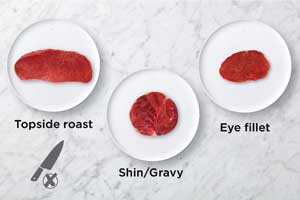
1 Cuts that need little to no trimming
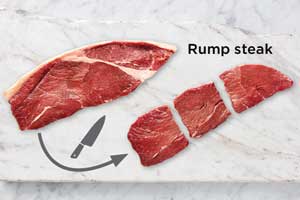
2 Cuts that need a little trimming
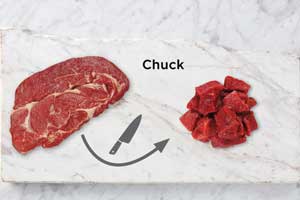
3 Cuts that need more trimming
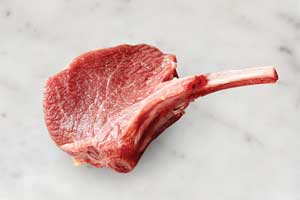
Protein portion size guide
Never sure how much meat to buy to feed your family? Or do you find you’re always left with loads of leftovers. Use this handy visual guide to get your portions right.
Smaller portions size (if you eat meat most nights)
Makes 1 meal
1 ‘minute steak or small medallion
1 small chop or cutlet
1 slice of roast meat

Makes 2 meals
1 medium steak sliced in thin strips
1 lamb shank
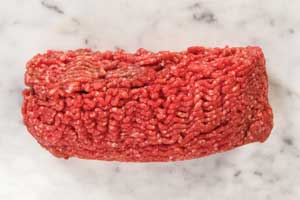
Makes 4 meals
500g mince
500g beff/pork/lamb strips or diced
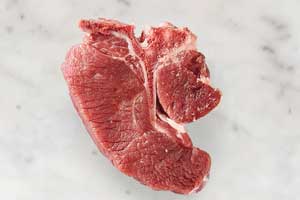
Larger portion size (if eating 3-4 times a week)
Makes 1 meal
1 medium steak
1 chop
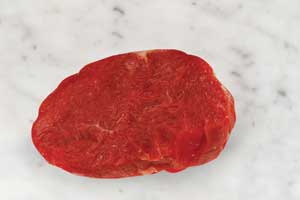
Makes 2 meals
1 large steak
